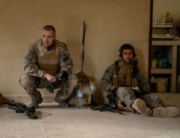Frame by Frame combines vérité, interviews and never-before-seen archival footage to showcase four Afghan photojournalists documenting their war-torn country.
The documentary opens with photojournalist Massoud Hossaini rushing to cover another suicide bombing and segues into historical television and radio reports over a montage of compelling historical photographs. This sets the scene of the country’s complex history: the Soviet invasion of 1979 and its withdrawal 10 years later that left a power vacuum, which descended into civil war from which the Taliban seized power in 1996. The Taliban’s fundamentalist regime enforced a media blackout and photography was banned, and taking a photograph became a crime. After the U.S. invasion of 2001 caused the Taliban to withdraw, a fledgling free press emerged.
After the Taliban defeat, National Geographic photographer Reza Deghati set up the AINA institute in Kabul to train Afghanis to pursue careers in photojournalism. It is here where these four all studied. Renowned Afghan photojournalist Najibullah Musafer, dubbed as the “father of Afghan Photography,” teaches at Kabul University. The only female, Farzana Wahidy, focuses on Afghan women, their segregation and exclusion from society, including prostitutes, those imprisoned for “moral crimes,” and those who have survived self-immolation and abuse. Wakil Kohsar’s family fled the Russian occupation and settled in Pakistan. Despite returning to find his home destroyed, he was happy to be back. Focusing his lens on politics, social issues, and youth culture, he is certain that “a photo can lead to change.”
Growing up in Iran after his family fled the Soviets, Massoud Hossaini became a political activist in his teens and began recording events with his camera, including Iran’s forgotten Afghani refugees. After the September 11 attacks, he returned to Afghanistan and studied at AINA before joining the Agence France-Presse. He has covered the war on terrorism ever since. His heartbreaking image of an 11-year-old girl, Tarana Akbari, screaming in terror amid the carnage of a suicide bomber’s attack won him the Pulitzer Prize.
Farzana Wahidy’s experiences and her practice are deeply affecting and insightful about the contemporary situation in Afghanistan. On a personal level, she is visibly distressed recollecting her brutalization on the street for not observing the strict dress code. She mourns the loss of any images of herself during her childhood and is enraged for her generation who were denied an education under the Taliban. Photographing women is still taboo in Afghanistan, and when Wahidy seeks to document in a hospital in Herat those who have attempted self-immolation, she is met with fear and denial. The burn unit doctor is adamant that her camera will endanger them all.
Wahidy’s husband, Massoud Hossaini, is conflicted about his work and the photograph that won him his Pulitzer. He still documents the annual religious event where the bomb exploded and visits the surviving family. Up-and-coming photographer Wakil Kohsar laments that during his lifetime he has never known his country at peace. His compassion for the homeless heroin addicts that he documents is clear as he urges them into rehabilitation and visits them in recovery. The eldest, Najibullah Musafer, originally trained as a painter. Remaining in Afghanistan through the conflicts, Musafer tells how he trading painted portraits of the mujahideen generals for his safety so that he could freely photograph the conflict. He shares his video footage never before seen—of the Taliban’s slaughter of “undesirables” as they retreated from northern Afghanistan. “My heart was crying, but I had no tears left to cry,” he says.
Directors Alexandria Bombach and Mo Scarpelli’s handsome cinematography captures the beauty of the country that shines through the devastation and the military debris. Reflective scenes punctuate the “action,” as when Musafer propels a blue, swan-shaped paddle boat that glides across a still lake while he marvels at the sheer beauty of the landscape. The editing is sensitive, holding back and letting interactions play out and moments resonate between the photographers and their sitters.
Through the photographers’ images and personal recollections, Bombach and Scarpelli build a deeper insight into the state of the nation that is all too often pigeonholed in the Western media. There has been a revolution in photography since the Taliban were defeated, but as foreign troops, media, and aid withdraw from Afghanistan, the hostility to a free press is evident. Yet the bravery, hope, and commitment of these photographers shines through, underscored by the film’s dedication to an Afghani correspondent who was recently killed.
While the end titles note the rising violence toward journalists, the on-going challenges were brought home again in February 2015. Shortly before the film’s world preview at SXSW Film Festival, Najibullah Musafer was jailed on a trumped up charge of “violating copyright law.” Ironically, he also spent seven months in prison under the Taliban for “photograph related crimes.” However this time, after international pressure, President Ashraf Ghani ordered his release in March.
Originally conceived as a short documentary and funded through a Kickstarter campaign, Frame by Frame is thought-provoking and a powerful testament.







Leave A Comment